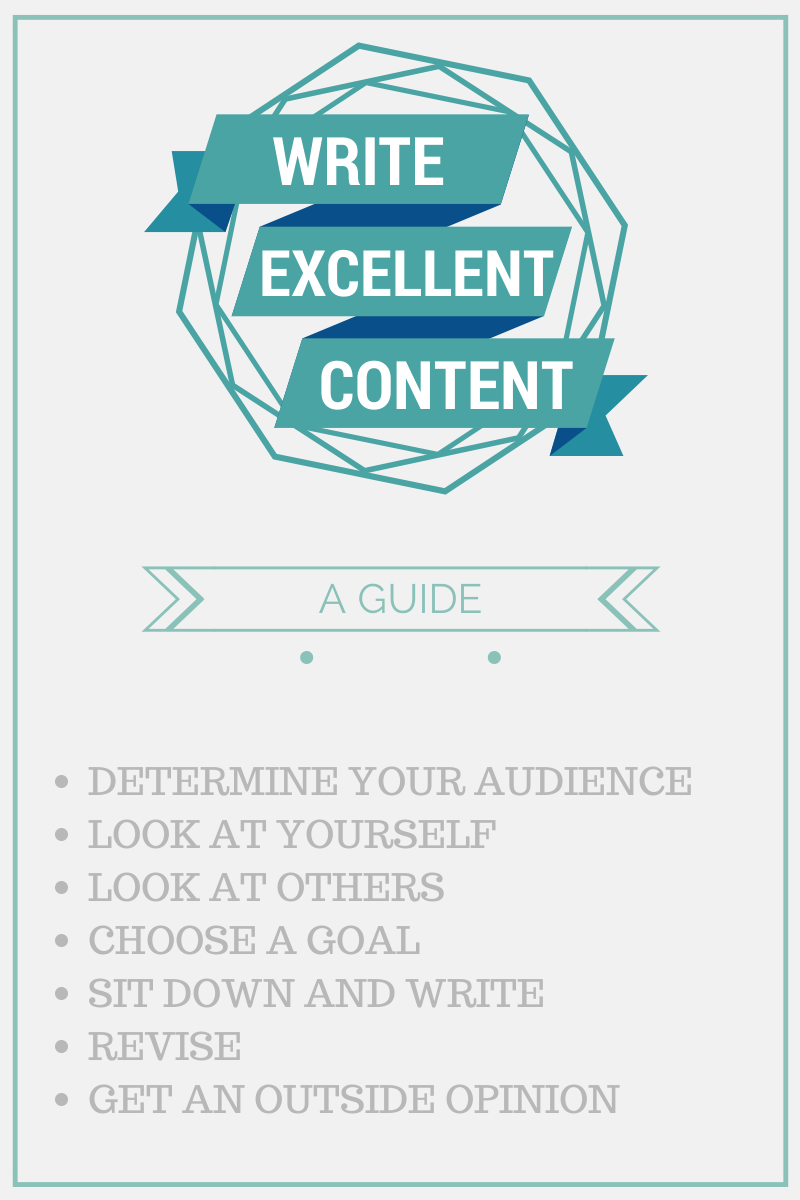
Content this, content that, content here, content there: content is everywhere. I’ve made my argument elsewhere that it’s an important part of your digital strategy, no matter your business size or type. And in order to reach your marketing and sales objectives, your content must be excellent. But I realized something lately: that lots of people don’t really understand what excellent content means, or how to reach that level of quality. The web is clogged with sub-par, badly written, uninteresting, plagiarized and useless content.
Quality content isn’t that difficult, but it requires a bit of thought, lots of practice and some advice from colleagues, clients and friends. Over the years, I’ve developed a not-so-secret method for excellent content and I’m going to share it with you today.
Step 1: Determine your audience
This advice is actually contrary to a lot of what you’ll read on the internet. You’ll often hear “start with your passion!” or “write for yourself!” Although it’s good advice for writing in general, when producing content for business, the roles are reversed. You’re not writing to express yourself through art; you’re here to inform, convince or entertain. If you don’t know who you’re talking to, at least in general terms, your content can easily miss the mark.
Let’s use an example. If you are in the beauty business, your audience is probably women. A blog post about beauty trends for men is not likely to interest them… unless it’s about how to get their boyfriends and husbands to adopt a beauty routine. One topic has many different angles, which may suit different audiences. It’s a bit how we convince our boss to adopt a new technology vs. how we tell our employees of the upcoming technology change.
In rhetorical terms, this is called audience analysis, and it is the first step for any business document, including business blog posts.
Step 2: Look at yourself
Who are you? What are you values, your goals, your aspirations? What fascinates and interests you? Who do you look up to? Who inspires you? Gathering momentum from myself is the way I start every piece of content. If I have already chosen a topic, I will do an inventory of my knowledge about it. What do I know about this? What do I not know? What are my questions and assumptions about this topic?
This section will often take the form of notes, especially if this is a new topic for me or if it’s a longer, research-based document. But because I’m an experienced writer, I do this part automatically for most blog posts. Beginning writers will find notes useful to get started and to structure their content.
It’s also really important to determine your own perspective on a topic. It will often have an effect on the tone and overall style of the piece. If you have an unusual or polemical perspective on a well-known topic, for example, you should take it into account. For example, I have a certain attitude towards SEO, and I’m not shy about it. But I’m honest and I can defend this opinion–and hopefully change other people’s too.
Step 3: Look at others
Nobody knows everything about everything. Even in subject matters where we are experts, there’s always something new to learn (or so I hope!) Looking at what others are saying about your topic is an important part of getting excellent content out there. You don’t want to repeat what’s already been said: you want a new perspective, a fresh take, a second opinion. (See step 2.) This step also involves doing factual research to support your claims (like statistics) and to fill gaps in your knowledge.
In rhetorical terms, this is called context analysis. You need to know in what context your content will be consumed to position it properly within that context.
Step 4: Choose a goal
Now that you know who you’re writing to, what you’re going to talk about and what other people are saying, you need to decide to what purpose you are writing. Are you writing to inform? Keep your tone neutral and factual. Are you expressing an opinion? Use personal style and argumentation techniques. Are you trying to entertain? Humour and a lighthearted language will work well. Your purpose in writing will dictate the language, format and flow of your piece.
For example, this is an informative piece. The flow is logical and has a step-by-step format. My post on sexualized social media ads was meant to be persuasive: I wanted to convince you to avoid using these types of ads on Facebook. The piece follows the typical nuanced opinion format and there’s more of my personal voice into it.
Your goal is at the heart of the language, formatting and style choices you will make for your piece.
Step 5: Sit down and write
This is simultaneously the easiest and the hardest part of producing excellent content. Especially for beginning writers, the fear of the blank page and a lack of confidence can defeat even the most determined. But if you’re a business, it needs to be done. So there’s no good reason to fret, delay and procrastinate. The writing will only be finished if you start it.
There are many techniques that writers use to get their writing done. Here are a few:
- Use deadlines
- Build a routine
- Program email/phone reminders
- Go to a quiet place
When you start writing more frequently, you’ll figure out the routine or motivation techniques that work best for you. The secret? Don’t give up, experiment and keep notes about your writing efficiency.
Step 6: Revise
Your writing doesn’t have to be perfect on the first draft. I repeat: your writing doesn’t have to be perfect on the first draft. Revision is just as important to writing as knowing your audience, getting ideas and writing the first draft. Think of revision as a way to “re-envision” your content with fresh eyes.
Revision isn’t just proofreading. Revision means being open to rewriting, restructuring and sometimes completely changing a piece. This is why getting plenty of time to write helps: you have time to let your piece rest before going back to it.
Step 7: Get an outside opinion
Sharing your writing with colleagues before publication will help you notice things you might not have during the revision phase. Writers tend to get really close to their own writing, and it’s easy to overlook things like assumptions, faulty logic, red herrings and other rhetorical mistakes. Before you hit “Publish”, make sure to have at least one or two people read through your content.
Of course, your beta readers will also note grammatical and spelling errors that you might have missed. It’s okay; everyone makes these errors. As long as you correct them before publishing, nobody will ever know!
You’re ready to write!
Here it is. Producing excellent content isn’t magic or rocket science; it’s applying a workable, efficient writing process every time you sit down to write.

This process is just a model; you can change it and add or remove some steps as you wish. Some people prefer to share their content earlier in the process to get feedback as they compose; others would rather show the most polished writing they can manage.
How about you? How do you approach business writing or content production tasks? Share you own process with our community!




